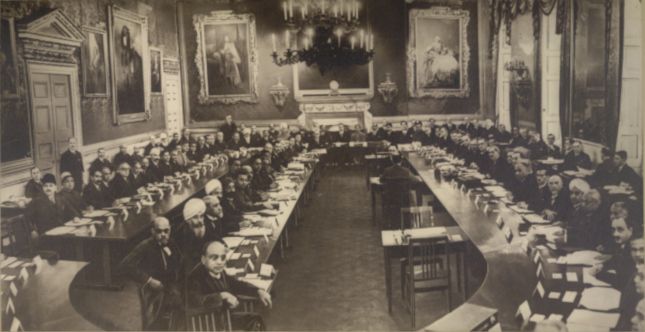For smooth Ad free experience
For smooth Ad free experience
The table is linear, agreement doesn't circle back to any point. These were also known as the peace conferences, as these were aimed at terminating the pandemonium India was dwindling in.

Happened on 12th November 1930
It was the time when the country was burning in a rage of fury and the streets were painted with the tainted blood of many freedom fighters. The Simon Commission, which was hugely unwelcomed in India, submitted a report when it returned to Britain. The report was clouded, so much that the authorities decided to organize Round Table Conferences for the future of the country. They decided to invite delegates from India to get a clearer view of their demands, with a bleak expectation of halting the national chaos.
The Round Table Conferences were held from 1930-32. These were also known as the peace conferences, as these were aimed at terminating the pandemonium India was dwindling in. These were hosted by George V, the King of Britain and Ramsay MacDonald, the British Prime Minister at that time. The demand which was voiced the most was a state of Swaraj or self-rule. What the British heard and discussed was granting of dominion status.
The First Round Table Conference was set on the date of November 12, 1930. It solely focused on the purpose of bringing in constitutional reforms in India. The conference was held at the House of Lords in London.
Sir Malcolm Hailey was the chief advisor; he had spent thirty years as an Indian civil servant. Lord Reading was appointed as the leading Liberal, for he could foresee the situation of India after attaining independence. From the British’s side, the number of emissaries was 16, a collective of each pair representing the political parties of Britain. And the Indian representatives numbered to 74- 58 political faces and 16 from the princely states.
However, no representative arrived from the Indian National Congress or any business leader joined the conference. Most of them were imprisoned due to the turmoil of Civil Disobedience Movement. The Indian leaders who were there as follows, Muhammad Ali Jinnah, Muhammad Safi, Muhammad Ali, Muhammad Zafrulla Khan, Aga Khan, A. K. Fazhul Haq (Muslim League), S. Moonje and Jaykar of Hindu Mahasabha, Tej Bahadur Sapru, Srinivasa Shastri and C. Y. Chintamani of Indian Liberty Party, Sardar Ujjal Singh – a delegate of the Sikhs and B. R. Ambedkar from the untouchable group.
The topics which were brought up and extensively discussed were the proposed federal structure of India, border disputes of Sindh and North West Frontier Provinces, discrepancies of Burma, issues entangling minorities. The outcomes were ultimately labeled as worthless sue to the absence of Indian National Congress.
Tej Bahadur Sapru put forward the idea of an All- India Federation. It was supported by the delegates of the Princely States, and the forces of Muslim League also joined. The British agreed to install a representative government at a provincial level. Dr. B. R. Ambedkar threw a bold move by demanding a separate electorate for the minorities.
With the failure of the conference, leaders like Tej Bahadur Sapru, C. Y. Chintamani pleaded Gandhi to talk to the Viceroy, Lord Irwin. In 1931, the factors which paved the way for INC’s invitation to the conference, where, Congress was asked to terminate the ongoing movements.
0
You might be interested in reading more from
